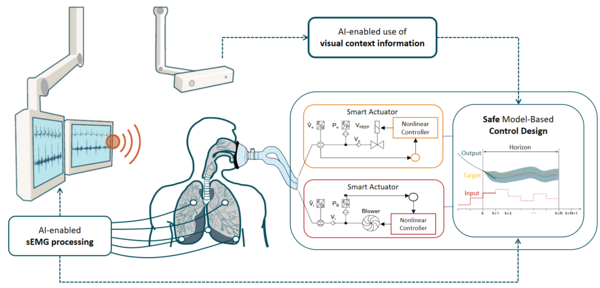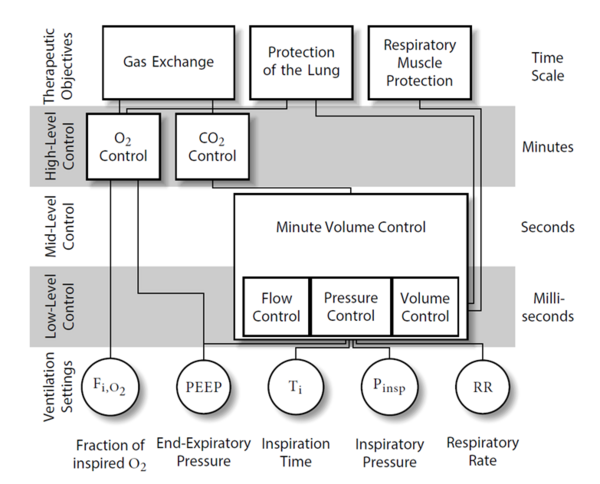Respiratory Monitoring & Control
Modeling, monitoring and control of respiratory support
Breathing is a process most of us take for granted, and its failure is a medical emergency. Providing personalized respiratory support is a huge challenge: Every patient has different metabolic needs, different respiratory anatomy and physiology, and a different natural breathing rhythm. Studies have shown that many patients are not ventilated in a way that supports their natural respiratory rhythm, potentially leading to grave consequences ranging from patient trauma due to a loss of autonomy over one’s own respiration over severe lung injury to death.
Our vision is a mechanical ventilator that…
- Monitors a patient’s own respiratory activity during mechanical ventilation,
- Identifies a model of the patient’s respiratory system, and
- Uses this information to optimally align ventilator support with the patient’s needs by using advanced control techniques.
More specifically, we…
- Apply advanced signal processing techniques to measurement modalities such as camera signals, respiratory surface EMG measurements and esophageal pressure measurements to obtain reliable measurements of respiratory activity.
- Model all aspects of the respiratory system, including respiratory mechanics and lung properties, gas exchange, and respiratory control mechanisms.
- Use modern control techniques such as model-predictive control (MPC) to design advanced ventilator control schemes based on these models and measurements.
2020
On the Estimation of Optoacoustic Waves in Retinal Laser Therapy Using Gaussian Processes, in Proc. Workshop Automed , Lübeck, Germany , Mar.2020.
Registration of Image Modalities for Analyses of Tissue Samples using 3D Image Modelling, PROTEOMICS -- Clinical Applications , 2020. Wiley.
| DOI: | {{10.1002/prca.201900143}} |
| File: | prca.201900143}} |
| Bibtex: | @article{HeBr20,
title={Registration of Image Modalities for Analyses of Tissue Samples using 3D Image Modelling},
author={Hermann, Juliane and Brehmer, Kai and Mahfoud, Felix and Speer, Timotheus and Schunk, Stefan J. and Tscherning, Thomas and Thiele, Herbert and Jankowski, Joachim},
journal={PROTEOMICS -- Clinical Applications},
year={2020},
publisher={Wiley},
} |
Removing Cardiac Artifacts From Single-Channel Respiratory Electromyograms, {IEEE} Access , vol. 8, pp. 30905--30917, 2020. Institute of Electrical and Electronics Engineers ({IEEE}).
| DOI: | 10.1109/access.2020.2972731 |
| File: | 8988257 |
| Bibtex: | @Article{PeSaGrRo20,
author = {Petersen, Eike and Sauer, Julia and Graßhoff, Jan and Rostalski, Philipp},
title = {Removing Cardiac Artifacts From Single-Channel Respiratory Electromyograms},
journal = {{IEEE} Access},
year = {2020},
volume = {8},
pages = {30905--30917},
doi = {10.1109/access.2020.2972731},
groups = {ECG Removal from EMG recordings},
publisher = {Institute of Electrical and Electronics Engineers ({IEEE})}
}
|
Scalable Gaussian Process Separation for Kernels with a Non-Stationary Phase, in Proceedings of the 37th International Conference on International Conference on Machine Learning (ICML) , 2020.
Spatio-Temporal Gaussian Processes for Separation of Ventilation and Perfusion Related Signals in EIT Data, in Proc. Workshop Automed , 2020.
Surface EMG-based Estimation of Breathing Effort for Neurally Adjusted Ventilation Control, in {Proceedings of the 21st IFAC World Congress} , 2020.
2019
Automatic Estimation of Respiratory Effort using Esophageal Pressure, in 2019 41st Annual International Conference of the IEEE Engineering in Medicine and Biology Society (EMBC) , Jul.2019. pp. 4646-4649.
| DOI: | 10.1109/EMBC.2019.8856345 |
| Bibtex: | @inproceedings{GrPeBeRo19,
author={J. {Graßhoff} and E. {Petersen} and T. {Becher} and P. {Rostalski}},
booktitle={2019 41st Annual International Conference of the IEEE Engineering in Medicine and Biology Society (EMBC)},
title={Automatic Estimation of Respiratory Effort using Esophageal Pressure},
year={2019},
pages={4646-4649},
doi={10.1109/EMBC.2019.8856345},
ISSN={1557-170X},
month={July}}
|
Deep Learning for Prediction of Diaphragm Activity from the Surface Electromyogram, in Directions in Biomedical Engineering , De Gruyter, 2019. pp. 17--20.
2018
Sparse Estimation for the Assessment of Muscular Activity based on sEMG Measurements, in Proc. 18th Symp. Syst. Ident. , 2018.
2017
A Template Subtraction Method for the Removal of Cardiogenic Oscillations on Esophageal Pressure Signals, in Proc. 39th Ann. Int. Conf. Eng. Med. Biol. Soc. , 2017.
Convolutive blind source separation of surface EMG measurements of the respiratory muscles, Biomed. Tech. , vol. 62, no. 2, pp. 171--181, 2017.
Members
Philipp Rostalski

Gebäude 19
philipp.rostalski(at)uni-luebeck.de
+49 451 3101 6200
Jan Graßhoff

Gebäude 19
j.grasshoff(at)uni-luebeck.de
+49 451 3101 6216
Georg Männel

Gebäude 19
ge.maennel(at)uni-luebeck.de
+49 451 3101 6214
Sandra Henn

Gebäude 19
s.henn(at)uni-luebeck.de
+49 451 3101 6225
Julia Sauer

Gebäude 19
j.sauer(at)uni-luebeck.de
+49 451 3101 6217
Carlotta Hennigs

Gebäude 19
carlotta.hennigs(at)uni-luebeck.de
+49 451 3101 6218
Franziska Bilda (née Schollemann)

Gebäude 19
franziska.bilda(at)uni-luebeck.de
+49 451 3101 6234





